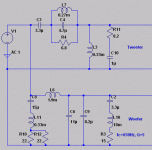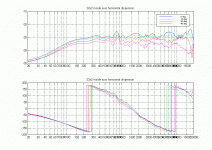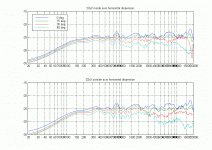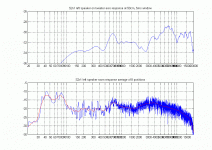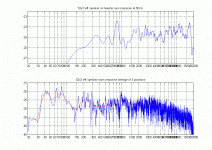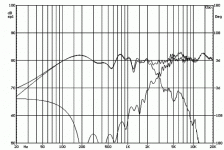Thanks guys!
vuki: That's very interesting. It may not be a cabinet problem afterall then. In the 8545K datasheet I can also see a small peak in the 650Hz range, but ScanSpeak naturally tweaks the measurement to make it look as good as possible.
Other than the uneven frequency response of this driver I really like the 8545K. I played some music yesterday with kettledrums and vocal, and the imaging of the speaker did not break down when the kettledrums hit as I have experienced with other speakers. I think this has to do with the low IMD of the 8545K drivers. Perhaps this 10 year old driver is better suited for modern digital xovers and eq's?
Bratislav: Well the xover is not so simple anymore. However being a bit of a cheapskate I was able to design all the existing components into the new xover. The biggest change is the notch at 650Hz. I also added an impedance flattening notch.
vuki: That's very interesting. It may not be a cabinet problem afterall then. In the 8545K datasheet I can also see a small peak in the 650Hz range, but ScanSpeak naturally tweaks the measurement to make it look as good as possible.
Other than the uneven frequency response of this driver I really like the 8545K. I played some music yesterday with kettledrums and vocal, and the imaging of the speaker did not break down when the kettledrums hit as I have experienced with other speakers. I think this has to do with the low IMD of the 8545K drivers. Perhaps this 10 year old driver is better suited for modern digital xovers and eq's?
Bratislav: Well the xover is not so simple anymore. However being a bit of a cheapskate I was able to design all the existing components into the new xover. The biggest change is the notch at 650Hz. I also added an impedance flattening notch.
Attachments
Now lets compare some before-and-after responses.
First the v1 (original) xover. Measured room response together with a zoomed in view of the speaker's on axis response.
Can you see the correlation? There's a bump at 700Hz in both plots, and the tweeter is 1 or 2 dB too hot.
First the v1 (original) xover. Measured room response together with a zoomed in view of the speaker's on axis response.
Can you see the correlation? There's a bump at 700Hz in both plots, and the tweeter is 1 or 2 dB too hot.
Attachments
Now the new v2 xover. Notice how the tweeter is not so hot anymore. In addition the bump at 700Hz is completely gone. Well almost. There's a bit left at 800Hz probably because of component tolerances in the notch filter.
The room response is much more even, the midrange more balanced with the high end. It drops off above 5kHz due too the waveguide tweeter and room absorption, completely normal.
The two bass resonances at 65 and 80Hz corresponds to the wall-to-wall distances of my living room. They can be reduced with a couple of eq filters.
That's it for now, thanks for reading through this
The room response is much more even, the midrange more balanced with the high end. It drops off above 5kHz due too the waveguide tweeter and room absorption, completely normal.
The two bass resonances at 65 and 80Hz corresponds to the wall-to-wall distances of my living room. They can be reduced with a couple of eq filters.
That's it for now, thanks for reading through this
Attachments
Hi ojg,
I would say there is to much presence (2kHz-5kHz) in the in-room response.
You could try to solve that by reducing the tweeter capacitor value, but then you'd have a notch at xover region.
Maybe it goes well with those bass nodes, but to me it doesn't seem right.
Also, most tweeters I heard sounded nicer when the xover point is above 2,5kHz - something that could be heard at higher listening levels. So my advice (although you obviously didn't ask for it) would be to push the xover point higher (the higher the better), which could get complicated with 18W8545...
Anyway... it really is an excellent project!
Regards,
Vuki
I would say there is to much presence (2kHz-5kHz) in the in-room response.
You could try to solve that by reducing the tweeter capacitor value, but then you'd have a notch at xover region.
Maybe it goes well with those bass nodes, but to me it doesn't seem right.
Also, most tweeters I heard sounded nicer when the xover point is above 2,5kHz - something that could be heard at higher listening levels. So my advice (although you obviously didn't ask for it) would be to push the xover point higher (the higher the better), which could get complicated with 18W8545...
Anyway... it really is an excellent project!
Regards,
Vuki
Hi vuki! You're right I didn't ask for your advice but I appreciate it a lot none the less! 
You're project seemed to turn out pretty well too. Is this your xover? It's pretty complex, but it has too be if you want to have 2nd order acoustic slopes with the 8545K. I went for LR4 acoustic slopes for both tweeter and woofer which is easier to achieve.
I believe the DXT tweeter can live with a low xover point as long as its 4th order. The DXT has a sensitivity of >95dB at 2kHz and so it is attenuated by more than 20dB at the 1kHz resonance frequency.
I will try out your advice with reducing the 2-5kHz region a couple of dB with a digital EQ.
You're project seemed to turn out pretty well too. Is this your xover? It's pretty complex, but it has too be if you want to have 2nd order acoustic slopes with the 8545K. I went for LR4 acoustic slopes for both tweeter and woofer which is easier to achieve.
I believe the DXT tweeter can live with a low xover point as long as its 4th order. The DXT has a sensitivity of >95dB at 2kHz and so it is attenuated by more than 20dB at the 1kHz resonance frequency.
I will try out your advice with reducing the 2-5kHz region a couple of dB with a digital EQ.
- Status
- This old topic is closed. If you want to reopen this topic, contact a moderator using the "Report Post" button.
- Home
- Loudspeakers
- Multi-Way
- My Seas DXT + SS18W speaker
